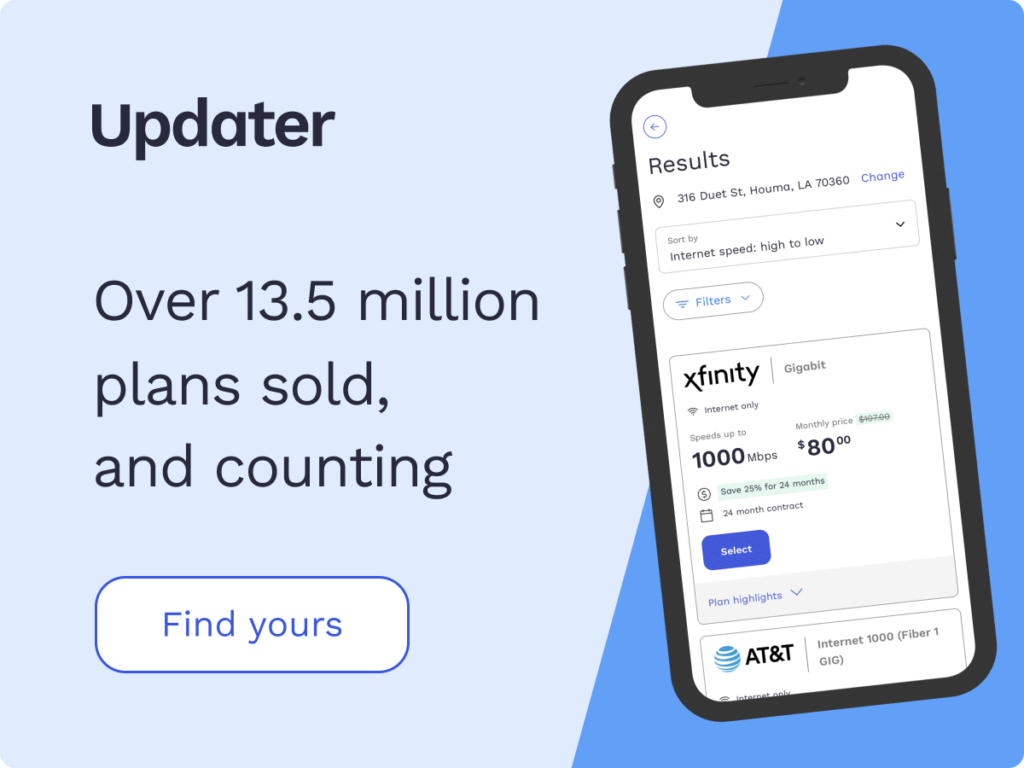A Guide to CenturyLink Compatible Modems

Before you can start enjoying a CenturyLink internet plan, you’ll need to have the right equipment, including a modem. It’s important to keep in mind that different modems are designed to handle different speeds and types of internet connections. This means that you can potentially purchase a modem that can’t deliver the maximum speed that CenturyLink internet offers. You may also buy an expensive unit capable of handling a wide range of speeds and internet connections, when you could’ve saved money getting one that matches the kind of service you have.
CenturyLink currently offers five different internet speeds; 940Mbps, 100Mbps, 40Mbps, 20Mbps and 10Mbps. We’ve researched many of the CenturyLink compatible modems currently available to create this guide that outlines the best modems for each CenturyLink speed package.
- What are some CenturyLink compatible modems?
- Should you rent or buy a modem?
- CenturyLink modem and router tips
- Choosing the right modem for CenturyLink internet
What are some CenturyLink compatible modems?
Zyxel C4000XG modem/router for up to 940Mbps
If you have CenturyLink’s fastest service, 940Mbps, then you have a fiber-optic connection and you may want to consider the Zyxel C4000XG. This router comes with several features that make it an ideal fit for 940Mbps internet service.
One of the most important features of the C4000XG, especially when it comes to 940Mbps service, is that it has a Wi-Fi 6 router inside. Wi-Fi 6 provides you with significantly faster speeds compared to Wi-Fi 5 or earlier iterations. The maximum throughput for a Wi-Fi 6 router is 9.6Gbps and for the C4000XG, it’s 6Gbps, which is over 6 times more than you would need with a 940Mbps plan. This means your Wi-Fi signal can be as fast as what you would get with an Ethernet connection.
Frequency Options with the Zyxel C4000XG
The C4000XG allows you to use two different frequency bands for your Wi-Fi; 2.4GHz and 5GHz. You can think of these like two different radio frequencies. Some other devices, such as printers or digital music production tools, may emit a frequency that conflicts with a 2.4Ghz signal. Switching to a 5Ghz channel can get rid of the interference and make for a more consistent internet connection.
Also, the C4000XG’s 5GHz channel may provide faster speeds than the 2.4GHz one, particularly if you’re closer to the modem or if there aren’t any walls or other obstructions in the way. This is because the higher the frequency band, the more data it can transmit. A higher frequency also means a more fragile signal that can be interrupted by obstructions and distance, which is why you need to be relatively close and ideally within eyesight of the modem when using the 5GHz frequency band.
The C4000XG is also compatible with a 160MHz channel, which means you can select that frequency and enjoy Wi-Fi over longer distances than you normally would. The speeds may be slower, but you can still check email and use online apps like Google docs without any trouble.
Drawbacks of the Zyxel C4000XG
One drawback of the C4000XG is that it can’t handle any kind of connection other than a fiber-optic one. This means that if you were to downgrade your service to one that doesn’t use fiber, your C4000XG would no longer be compatible. Also, if you left CenturyLink and switched to another service that didn’t provide a fiber connection, you couldn’t use the C4000XG modem.
Zyxel C4000LG modem/router for up to 100Mbps
If your CenturyLink service offers speeds up to 100Mbps, you may want to consider the Zyxel C4000LG. While this modem isn’t as powerful as the C4000XG, it comes with features that provide you with more than enough throughput and connectivity for 100Mbps service.
Like the C4000XG, the Zyxel C4000LG provides you with multiple channels, including 2.4GHz and 5GHz, giving you flexibility in terms of your maximum speed and ways to combat interference. The C4000LG maxes out at 3000Mbps of throughput if you’re using both the 2.4GHz and 5GHz channels simultaneously, which is far more than you’d need with a 100Mbps connection.
One aspect of the C4000LG that makes it a particularly good fit for 100Mbps service is its ability to accept a DSL connection. It can support both ADSL and VDSL, and because you’ll likely have VDSL service if you have CenturyLink’s 100Mbps plan, the C4000LG is definitely worth considering.
Drawbacks of the C4000LG
A significant drawback of the C4000LG is that its support for VDSL only goes up to VDSL 17a. This technology maxes out your download speed at 100Mbps, but it also limits your upload speed to 50Mbps. If CenturyLink were to offer you upload speeds higher than 50Mbps, you wouldn’t be able to upload more than 50Mbps and this could present a problem. For example, if you have several gamers playing at the same time, as well as people streaming high-definition video from their devices or videoconferencing, there could be interruptions.
Axon C4000BG modem/router for 10, 20, or 40Mbps
A great choice for services that peak between 10 and 40Mbps is the Axon C4000BG. This unit gives you many of the same benefits as the Zyxel C4000LG, such as throughput up to 3000Mbps, 2.4GHz and 5GHz frequencies, and ADSL and VDSL compatibility. But, it also offers two DSL ports. This enables you to set up a wide area network (WAN) and with a WAN, you can connect multiple networks together.
Drawbacks of the Axon C4000BG
There are very few drawbacks of the Axon C4000BG for people with 40, 20, or 10Mbps of service. It has enough throughput to handle whatever speeds CenturyLink makes possible with those services, for both downloading and uploading. The one downside would be that you may have to get a new modem if you were to upgrade your service to a higher speed plan.
Also, the Axon C4000BG has the same limitation as the Zyxel C4000LG when it comes to only providing VDSL up to version 17a, so if you upgraded to a service that provides faster upload speeds, you may have to purchase a different unit to take advantage of them.
Should you rent or buy a modem?
If you plan on keeping your CenturyLink internet service for at least 16 months, it’s better to buy your modem. While prices vary, the most you’ll pay for a new modem is around $240, and you may be able to find cheaper prices at different times of the year. The monthly equipment rental fee with CenturyLink is $15, so after around 16 months you would have paid the same amount in rental fees as if you bought your modem outright, assuming you got it for about $240 or less.
CenturyLink modem and router tips
When setting up a CenturyLink modem/router, it may be helpful to:
- – Position it in a central location where people tend to use the internet, such as in a living room or entertainment room.
- – Use the 5GHz frequency band, especially if users are relatively close to the modem.
- – Ask CenturyLink about the kind of service you have before purchasing a modem. You should specifically ask if you have fiber-optic service or DSL. And if you have DSL, it’s best to know which specific type of connection you have, either ADSL or VDSL.
Choosing the right modem for CenturyLink internet
When it comes to choosing the right CenturyLink modem, there are a few features in particular that you should look for.
Pair bonding
With pair bonding, you get as much as double the bandwidth as you would if you had normal, single line, DSL service. Here’s how pair bonding works:
- – With normal DSL service, there are two copper lines coming into your home. One handles downloads and the other handles uploads.
- – With pair bonding, you get double the number of copper lines: two for downloads and two for uploads. This means your DSL speeds can be twice as fast, depending on the kind of DSL you have and your modem.
- – With CenturyLink, if your regular DSL service already maxes out at 100Mbps the most speed you can get with pair bonding is 140Mbps.
If you have a DSL internet connection, which kind do you have?
If you have CenturyLink’s DSL service, it may not matter which of these modems you choose, depending on the type of DSL you have. DSL stands for “direct subscriber line,” and it brings your internet signal in through a phone line, making it possible for you to enjoy relatively fast internet speeds. To put DSL into perspective, before it gained popularity, the most common kind of internet signal was Integrated Services Digital Network (ISDN), which topped out at 128Kbps. That’s equal to 0.128Mbps, which is about 39 times slower than a 5Mbps connection. Modern DSL, on the other hand, offers much faster speeds than both ISDN and early DSL, and CenturyLink provides you with a few different options: ADSL, ADSL2, and VDSL. The slowest of these services is ADSL, the next fastest is ADSL2, and the fastest is VDSL.
All of the devices highlighted in this guide can take all three types of DSL. But if you have CenturyLink internet, it’s important to know the maximum speed of your service. Once you know the top speed of your DSL service, you can check it against the maximum speeds of CenturyLink compatible routers. Fortunately, they can all handle the maximum DSL speeds for each type of DSL. Here are the top speeds your CenturyLink router can handle, broken down by DSL type:
- – ADSL: As fast as 7Mbps
- – ADSL2: As fast as 20Mbps
- – VDSL: As fast as 100Mbps
The only way to get “more speed” is if your connection uses pair bonding, as described above. In that case, If you have ADSL2, you can get up to 40Mbps, instead of 20Mbps. Also, if you have VDSL with pair bonding, you can get as much as 140Mbps instead of 100Mbps.
*Pricing varies by location and availability. Speeds may vary. All prices subject to change; for current pricing and availability visit our internet service page. Prices as of 3/16/22.
Disclosure | Updater articles are based on our own data and research, independent from partner relationships. We are not compensated by partners for information and opinions presented here. Our Editorial Terms of Service can be found here.














